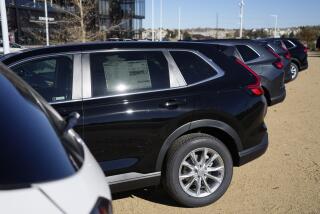VIEWPOINTS : 1987: Looking Ahead to a Year of Big Changes : Auto Sales to Rise
In 1987, you’re likely to see big changes in just about everything you buy. If you’re planning a vacation, you’ll notice differences whether you drive or travel by air. If you want to buy a home, you’ll be watching prices and mortgage rates closely. Eating out? You’ll see some unusual, new menus. The worlds of entertainment and retailing are in a state of upheaval. And, with a new tax law, investing may be more tricky than ever.
The Times polled experts in eight fields for their outlook on what 1987 will mean for businesses and consumers.
New-car dealers have reason to celebrate this holiday season, since they should finish 1986 with total sales of 11.15 million new cars and 4.6 million light trucks--a combined record.
Most industry experts, however, believe that 1987 sales will fall short of this year’s record performance. We don’t think so. We’re predicting that 1987 new-car sales will be even better than those of 1986.
Much of the market’s strength has been attributed to generally good economic conditions and boosted by liberal incentive programs and the rebirth of low-priced cars such as the Hyundai Excel and the Yugo GV. While slower economic growth and reduced consumer confidence may affect next year’s sales, other factors directly related to the auto industry should more than offset a slight decline in the economy.
Most domestic manufacturers plan to bring in more models from outside the United States. In addition, new nameplates--such as Sterling and Range Rover--will help make a record number of cars available. This wider selection, augmented by a barrage of new low-priced cars from mainstream manufacturers and additional U.S. assembly of Japanese-make cars, will create a much more competitive selling environment. This, in turn, will result in a new wave of incentive programs from both domestic and import manufacturers, which should entice more consumers into the new-car market.
As a result, we predict that 1987 new-car sales will reach 11.4 million in the United States and 1.24 million in California (up from 1.2 million in 1986). We also expect new-truck sales to grow, although at a slower rate.
New entries from South Korea should bring the import manufacturers’ share of total sales to 31% nationwide and 49% in California. However, we foresee only moderate growth for the Japanese companies, hard hit by the decline of the dollar in recent months. To compensate for cumulative price increases of around 13% in the past year, Japanese auto makers are likely to market their cars even more aggressively.
The Big Three domestics (GM, Ford, and Chrysler) will be hoping to regain some of their market share from the Japanese, as well as fighting it out among themselves. All three--especially GM--have to be as concerned about profits as about sales volume. Even so, any signs of slowing demand are likely to be met with heavy promotions and renewed incentive programs.
This intense competition, spurred by excess production capacity and coupled with a modestly favorable economic outlook, should ensure high new-car and light-truck sales for 1987.
More to Read
Inside the business of entertainment
The Wide Shot brings you news, analysis and insights on everything from streaming wars to production — and what it all means for the future.
You may occasionally receive promotional content from the Los Angeles Times.










